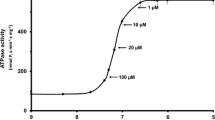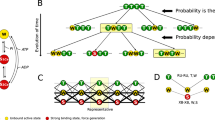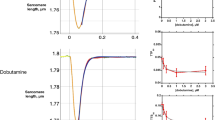Summary
The distribution of Ca2+ and Mg2+ among the ‘regulatory’ cation binding sites of troponin (T-sites) and the strong, Ca2+-Mg2+ binding sites of troponin and parvalbumins (P-sites) in the sarcoplasm of a muscle was calculated. At rest, 60% of the T-sites were metal free, while 92% of the P-sites were loaded with Mg2+.
In response to a Ca2+ pulse, troponin-calcium (T-Ca) complexes were rapidly formed, while the binding of Ca2+ to P-sites was limited by the slow rate of dissociation of the parvalbumin-magnesium (P-Mg) complexes. Muscle activation was not prevented by a high content of parvalbumins.
Parvalbumin and the sarcoplasmic reticulum (SR) pump were complementary relaxing factors that removed Ca2+ from the cytosol and from the T-sites. Parvalbumins dominated the first part of relaxation, while the action of the SR was essential to ensure the return to a very low level of free Ca2+ ion and of T-Ca. After relaxation, a large fraction of the Ca2+ pulse was still bound to parvalbumins and returned slowly to the SR during the recovery.
When the SR activity was reduced, the presence of parvalbumins preserved a fast rate of relaxation, at least for a few contractions. This may have a high adaptive value in cold-blooded animals.
Similar content being viewed by others
References
ASHLEY, C. C. & CAMPBELL, A. K. (1979)Detection and Measurement of Free Ca 2+ in Cells. Amsterdam: Elsevier/North Holland.
ASHLEY, C. C., CALDWELL, P. C., LOWE, A. G., RICHARDS, C. D. & SCHIRMER, M. (1965) The amount of injected EGTA needed to suppress the contractile responses of single Maia muscle fibres and its relation to the amount of calcium released during contraction.J. Physiol. 179, 32–3P.
ASHLEY, C. C., MOISESCU, D. G. & ROSE, R. M. (1974) Kinetics of calcium during contraction: myofibrillar and SR fluxes during a single response of a skeletal muscle fibre. InCalcium Binding Proteins (edited by DRABIKOWSKI, W., STRZELECKA-GOLASZEWSKA, M. and CARAFOLI, E.), pp. 609–642. Amsterdam: Elsevier.
ASHLEY, C. C. & RIDGEWAY, E. B. (1970) On the relationships between membrane potential, calcium transient and tension in single barnacle muscle fibres.J. Physiol. 209, 105–30.
BARON, G., DEMAILLE, J. & DUTRUGE, M. (1975) The distribution of parvalbumins in muscle and other tissues.FEBS Lett. 56, 156–60.
BHUSHANA RAO, K. S. P. & GERDAY, C. (1973) Low molecular weight proteins of pike (Esox minus) white muscles. I. Extraction and purification-polymorphism.Comp. Biochem. Physiol. 44B, 931–7.
BLINKS, J. R. (1973) Calcium transients in striated muscle cells.Eur. J. Cardiol. 1, 135–42.
BLINKS, J. R., RÜDEL, R. & TAYLOR, S. R. (1977) Calcium transients in isolated amphibian skeletal muscle fibres: detection with aequorin.J. Physiol. 277, 291–323.
BLUM, H. E., LEHKY, P., KOHLER, L., STEIN, E. A. & FISHER, E. H. (1977) Comparative properties of vertebrate parvalbumins.J. biol. Chem. 252, 2834–8.
BLUM, H. E., POCINWONG, S. & FISHER, E. H. (1974) A phosphate acceptor protein related to parvalbumins in dogfish skeletal muscle.Proc. natn. Acad. Sci. 71, 2198–202.
BONE, Q. (1966) On the function of the two types of myotomal muscle fibre in elasmobranch fish.J. mar. Biol. Ass. U.K. 46, 321–49.
BRIGGS, N. (1975) Identification of the soluble relaxing factor as a parvalbumin.Fed. Proc. 34, 540.
CAMPBELL, A. K., LEA, T. J. & ASHLEY, C. C. (1979) Coelenterate photoproteins. InDetection and Measurement of Free Ca 2+ in Cells (edited by ASHLEY, C. C. and CAMPBELL, A. K.), pp. 13–72. Amsterdam: Elsevier.
COHEN, S. M. & TYLER-BURT, C. (1977)31P nuclear magnetic relaxation studies of phosphocreatine in intact muscle: Determination of intracellular free magnesium.Proc. natn. Acad. Sci. 74, 4271–5.
COX, J. A., WNUK, W. & STEIN, E. A. (1977) Regulation of calcium binding by magnesium. InCalcium-binding Proteins and Calcium Function (edited by WASSERMAN, R. H., CORRADINO, R. A., CARAFOLI, E., KRETZINGER, R. H., MACHENNAN, D. H. and SIEGEL, F. L.), pp. 266–269. New York: North-Holland.
CURTIN, N. A. & WOLEDGE, R. C. (1978) Energy changes and muscular contraction.Physiol. Rev. 58, 690–761.
DEMAILLE, J., DUTRUGE, E., CAPONY, J.-P. & PECHÈRE, J.-F. (1974a) Muscular parvalbumins: A family of homologous calcium-binding proteins. Their relation to the calcium-binding troponin component. InCalcium Binding Proteins (edited by DRABIKOWSKI, W., STRZELECKA-GOLASZEWSKA, M. and CARAFOLI, E.), pp. 643–677. Amsterdam: Elsevier.
DEMAILLE, J., DUTRUGE, E., EISENBERG, G., CAPONY, J. P. & PECHÈRE, J. F. (1974b) Troponins C from reptile and fish muscles and their relation to muscular parvalbumins.FEBS Lett. 42, 173–8.
DEMAILLE, J., DUTRUGE, E., BARON, G., PECHÈRE, J.-F. & FISCHER, E. H. (1975) A reappraisal of the relationship of phosphate-acceptor protein to parvalbumin.Biochem. biophys. Res. Commun. 67, 1034–40.
DIEBLER, H., EIGEN, M., ILGENFRITZ, G., MAASS, G. & WINKLER, R. (1969) Kinetics and mechanism of reactions of main group metal ions with biological carriers.Pure. Appl. Chem. 20, 93–115.
EBASHI, S., ENDO, M. & OHTSUKI, I. (1969) Control of muscle contraction.Q. Rev. Biophys. 2, 351–84.
ENDO, M. (1977) Calcium release from the sarcoplasmic reticulum.Physiol. Rev. 57, 71–108.
GEAR, C. W. (1971)Numerical Initial Value Problems in Ordinary Differential Equations. pp. 158–166. Englewood Cliffs, New Jersey: Prentice-Hall.
GERDAY, C., & GILLIS, J. M. (1976) The possible role of parvalbumins in the control of contraction.J. Physiol., Lond. 258, 96P.
GILLIS, J. M. & GERDAY, C. (1977) Calcium movement between myofibrils, parvalbumins and sarcoplasmic reticulum in muscle. InCalcium-binding Proteins and Calcium Function (edited by WASSERMAN, R. M., CORRADINO, R. A., CARAFOLI, E., KRETZINGER, R. H., MACLENNAN, D. H. and SIEGEL, F. L.), pp. 193–196. New York: North Holland.
GILLIS, J. M., PIRONT, A. & GOSSELIN-REY, C. (1979) Parvalbumins: distribution and physical state inside the muscle cell.Biochim. biophys. Acta 585, 444–50.
GILLIS, J. M. (1980) The biological significance of muscle parvalbumins. InCalcium Binding Proteins: Structure and Function (edited by SIEGEL, F. L., CARAFOLI, E., KRETZINGER, R. H., MACLENNAN, D. H. and WASSERMAN, R. H.), pp. 309–311, Amsterdam: Elsevier/North-Holland.
GOSSELIN-REY, C. & GERDAY, C. (1977) Parvalbumins from frog skeletal muscle (Rana temporaria). Isolation and characterization, structural modifications associated with calcium binding.Biochim. biophys. Acta 492, 53–63.
HAMOIR, G. (1968) The comparative biochemistry of fish sarcoplasmic proteins.Acta Zool. Path. Antver. 46, 69–76.
HAMOIR, G. (1974) Earlier and recent work on parvalbumins.Symp. Biol. Hung. 17, 17–33.
HAMOIR, G., GERARDIN-OTTHIERS, N. & FOCANT, B. (1980) Protein differentiation of the superfast swimbladder muscle of the toadfishOpsanus tau.J. molec. Biol. 143, 155–60.
HEIZMANN, G. W., HAUPTLE, M. T. & EPPENBERGER, H. M. (1977) The purification, characterization and localization of a parvalbumin-like protein from chicken-leg muscle.Eur. J. Biochem. 80, 433–41.
HITCHCOCK, S. E. & KENDRICK-JONES, J. (1975) Myosin light chains, carp calcium binding protein, and troponin components: Do they interact to form functional complexes? InCalcium Transport in Contraction and Secretion (edited by CARAFOLI, E., CLEMENTI, F., DRABIKOWSKI, W. and MARGRETH, A.), pp. 447–458. Amsterdam: North-Holland.
HOMSHER, E. & KEAN, C. J. (1978) Skeletal muscle energetics and metabolism.Ann. Rev. Physiol. 40, 93–131.
INESI, G. & SCARPA, A. (1972) Fast kinetics of adenosine triphosphate dependent Ca2+ uptake by fragmented sarcoplasmic reticulum.Biochemistry 11, 356–9.
INESI, G. & WATANABE, S. (1967) Temperature dependence of ATP hydrolysis and calcium uptake by fragmented sarcoplasmic membranes.Archs Biochem. Biophys. 121, 665–71.
JOHNSON, J. D., CHARLTON, S. C. & POTTER, J. D. (1979) A fluorescence stopped-flow analysis of Ca2+ exchange with troponin-C.J. biol. Chem. 254, 3497–502.
MCCRAKEN, D. D. & DORN, W. S. (1966)Numerical Methods and Fortran Programming. New York: John Wiley.
PEACHEY, L. D. (1965) The sarcoplasmic reticulum and transverse tubule of the frog's sartorius.J. Cell Biol. 25, 209–31.
PECHÈRE, J. F. & FOCANT, B. (1965) Carp myogens of white and red muscles. Gross isolation on Sephadex columns of the low molecular weight components and examination of their participation in anaerobic glycogenolysis.Biochem. J. 96, 113–8.
PECHÈRE, J. F., CAPONY, J. P. & RYDEN, L. (1971) The primary structure of the major parvalbumin from hake muscle: Isolation and general properties of the protein.Eur. J. Biochem. 23, 421–8.
PECHÈRE, J. F., DEMAILLE, J., DUTURGE, E., CAPONY, J. P., BARON, G. & PINA, C. (1975) Muscular parvalbumins. Some explorations into their possible biological significance. InCalcium Transport in Contraction and Secretion (edited by CARAFOLI, E., CLEMENTI, F., DRABIKOWSKI, W. and MARGRETH, A.), pp. 459–468. Amsterdam: North Holland.
PECHÈRE, J. F., DERANCOURT, J. & HAIECH, J. (1977) The participation of parvalbumins in the activation-relaxation cycle of vertebrate fast skeletal muscle.FEBS Lett. 75, 111–4.
POTTER, J. D. & GERGELY, J. (1975) The calcium and magnesium binding sites of troponin and their role in the regulation of myofibrillar adenosine triphosphatase.J. biol. Chem. 250, 4628–33.
POTTER, J. D., JOHNSON, J. D. & MANDEL, F. (1978) Fluorescence stopped flow measurements of Ca2+ and Mg2+ binding to parvalbumins.Fed. Proc. 37, 1608.
POTTER, J. D., JOHNSON, J. D., DEDMAN, J. R., SCHREIBER, W. E., MANDEL, F., JACKSON, R. L. & MEANS, A. R. (1977) InCalcium-binding Proteins and Calcium Function (edited by WASSERMAN, R. H., CORRADINO, R. A., CARAFOLI, E., KRETZINGER, R. H., MacLENNAN, D. H. and SIEGEL, F. L.), pp. 239–250. New York: North Holland.
POTTER, J. D., ROBERTSON, S. P., COLLINS, J. H. & JOHNSON, J. D. (1980) The role of the Ca2+ and Mg2+ binding sites on troponin and other myofibrillar proteins in the regulation of muscle contraction. InCalcium Binding Proteins: Stucture and Function (edited by SIEGEL, F. L., CARAFOLI, E., KRETZINGER, R. H., MacLENNAN, D. H. and WASSERMAN, R. M.), pp. 279–288. Amsterdam: Elsevier/North-Holland.
RALSTON, A. & RABINOWITZ, P. (1978)A First Course in Numerical Analysis. 2nd edn. New York: McGraw-Hill.
ROBERTSON, S. P., JOHNSON, J. D. & POTTER, J. D. (1981) The time-course of Ca2+ exchange with calmodulin, troponin, parvalbumin, and myosin in response to transient increases in Ca2+.Biophys. J. 34, 559–69.
SHAMPINE, L. F. & GEAR, C. W. (1979) A user's view of solving stiff ordinary differential equations.SIAM Rev. 21, 1–17.
SOMLYO, A. V., GONZALEZ-SERRATOS, H., SCHUMAN, H., MCCLEILAN, G. & SOMLYO, A. P. (1981) Calcium release and ionic changes in the sarcoplasmic reticulum of tetanized muscle: an electron probe study.J. Cell Biol. 90, 577–94.
WEBER, A. M., HERZ, R. & REISS, I. (1966) Studies of the kinetics of calcium transport by isolated fragmented sarcoplasmic reticulum.Biochem. Z. 345, 329–41.
WINEGRAD, S. (1968) Intracellular calcium movements of frog skeletal muscle during recovery from tetanus.J. gen. Physiol. 51, 65–83.
Author information
Authors and Affiliations
Additional information
Ed. notation: Free calcium ion (free Ca2+); bound calcium ion (bound Ca2+).
Rights and permissions
About this article
Cite this article
Gillis, J.M., Thomason, D., Lefèvre, J. et al. Parvalbumins and muscle relaxation: a computer simulation study. J Muscle Res Cell Motil 3, 377–398 (1982). https://doi.org/10.1007/BF00712090
Received:
Revised:
Issue Date:
DOI: https://doi.org/10.1007/BF00712090




